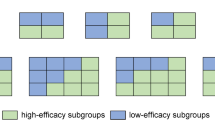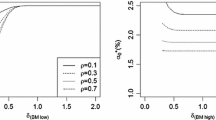Abstract
Predictive and prognostic biomarkers play an important role in personalized medicine to determine strategies for drug evaluation and treatment selection. In the context of continuous biomarkers, identification of an optimal cutoff for patient selection can be challenging due to limited information on biomarker predictive value, the biomarker’s distribution in the intended use population, and the complexity of the biomarker relationship to clinical outcomes. As a result, prespecified candidate cutoffs may be rationalized based on biological and practical considerations. In this context, adaptive enrichment designs have been proposed with interim decision rules to select a biomarker-defined subpopulation to optimize study performance. With a group sequential design as a reference, the performance of several proposed adaptive designs are evaluated and compared under various scenarios (e.g., sample size, study power, enrichment effects) where type I error rates are well controlled through closed testing procedures and where subpopulation selections are based upon the predictive probability of trial success. It is found that when the treatment is more effective in a subpopulation, these adaptive designs can improve study power substantially. Furthermore, we identified one adaptive design to have generally higher study power than the other designs under various scenarios.












Similar content being viewed by others
References
Simon RM (2013) Genomic clinical trials and predictive medicine. Cambridge University Press, Cambridge
Mandrekar SJ, Sargent DJ (2009) Clinical trial designs for predictive biomarker validation: theoretical considerations and practical challenges. J Clin Oncol 27(24):4027–4034
Simon R, Maitournam A (2004) Evaluating the efficiency of targeted designs for randomized clinical trials. Clin Cancer Res 10(20):6759–6763
Maitournam A, Simon R (2005) On the efficiency of targeted clinical trials. Stat Med 24(3):329–339
Scher HI et al (2011) Adaptive clinical trial designs for simultaneous testing of matched diagnostics and therapeutics. Clin Cancer Res 17(21):6634–6640
Sikorski R, Yao B (2009) Parallel paths to predictive biomarkers in oncology: uncoupling of emergent biomarker development and phase III trial execution. Sci Transl Med. doi:10.1126/scitranslmed.3000287
Wang S-J, James Hung HM, O’Neill RT (2009) Adaptive patient enrichment designs in therapeutic trials. Biometr J 51(2):358–374
Mehta C et al (2009) Optimizing trial design: sequential, adaptive, and enrichment strategies. Circulation 119(4):597–605
Song JX (2014) A two-stage patient enrichment adaptive design in phase II oncology trials. Contempor Clin Trials 37(1):148–154
Proschan MA, Waclawiw MA (2000) Practical guidelines for multiplicity adjustment in clinical trials. Control Clin Trials 21(6):527–539
Alosh M, Huque MF (2009) A flexible strategy for testing subgroups and overall population. Stat Med 28(1):3–23
Kim ES et al (2011) The BATTLE trial: personalizing therapy for lung cancer. Cancer Discov 1(1):44–53
Liu A et al (2010) A threshold sample-enrichment approach in a clinical trial with heterogeneous subpopulations. Clin Trials 7(5):537–545
Rosenblum M, van der Laan MJ (2011) Optimizing randomized trial designs to distinguish which subpopulations benefit from treatment. Biometrika 98(4):845–860
Wang S-J, O’Neill RT, Hung HMJ (2007) Approaches to evaluation of treatment effect in randomized clinical trials with genomic subset. Pharm Stat 6(3):227–244
Simon N, Simon R (2013) Adaptive enrichment designs for clinical trials. Biostatistics 14(4):613–625
Brannath W et al (2009) Confirmatory adaptive designs with Bayesian decision tools for a targeted therapy in oncology. Stat Med 28(10):1445–1463
Bretz F et al (2006) Confirmatory seamless phase II/III clinical trials with hypotheses selection at interim: general concepts. Biometr J 48(4):623–634
Hommel G (2001) Adaptive modifications of hypotheses after an interim analysis. Biometr J 43(5):581–589
Bauer P, Kieser M (1999) Combining different phases in the development of medical treatments within a single trial. Stat Med 18(14):1833–1848
Kieser M, Bauer P, Lehmacher W (1999) Inference on multiple endpoints in clinical trials with adaptive interim analyses. Biometr J 41(3):261–277
Schäfer H, Müller H-H (2001) Modification of the sample size and the schedule of interim analyses in survival trials based on data inspections. Stat Med 20(24):3741–3751
Wassmer G (2006) Planning and analyzing adaptive group sequential survival trials. Biometr J 48(4):714–729
Shen Y, Cai J (2003) Sample size reestimation for clinical trials with censored survival data. J Am Stat Assoc 98(462):418–426
Simes RJ (1986) An improved Bonferroni procedure for multiple tests of significance. Biometrika 73(3):751–754
Lehmacher W, Wassmer G (1999) Adaptive sample size calculations in group sequential trials. Biometrics 55(4):1286–1290
Bauer P, Kohne K (1994) Evaluation of experiments with adaptive interim analyses. Biometrics 50(4):1029–1041
Brannath W, Posch M, Bauer P (2002) Recursive combination tests. J Am Stat Assoc 97(457):236–244
Proschan MA, Hunsberger SA (1995) Designed extension of studies based on conditional power. Biometrics 51(4):1315–1324
O’Brien PC, Fleming TR (1979) A multiple testing procedure for clinical trials. Biometrics 35(3):549–556
Hothorn T, Zeileis A (2008) Generalized maximally selected statistics. Biometrics 64(4):1263–1269
Faraggi D, Simon R (1996) A simulation study of cross-validation for selecting an optimal cutpoint in univariate survival analysis. Stat Med 15(20):2203–2213
Williams, B. et al. (2006) Finding optimal cutpoints for continuous covariates with binary and time-to-event outcomes. http://www.mayo.edu/research/documents/biostat-79pdf/doc-10027230
Su M, Fang L, Su Z (2013) A likelihood and resampling based approach to dichotomizing a continuous biomarker in medical research. J Biopharm Stat 23(3):637–647
Zucker DM, Agami S, Spiegelman D (2013) Testing for a changepoint in the cox survival regression model. J Stat Theory Pract 7(2):360–380
Author information
Authors and Affiliations
Corresponding author
Appendix: Simulation Setup and Results
Appendix: Simulation Setup and Results
See Tables 1, 2, 3, 4, 5, 6, and 7.
Rights and permissions
About this article
Cite this article
Tang, R., Ma, X., Yang, H. et al. Biomarker-Defined Subgroup Selection Adaptive Design for Phase III Confirmatory Trial with Time-to-Event Data: Comparing Group Sequential and Various Adaptive Enrichment Designs. Stat Biosci 10, 371–404 (2018). https://doi.org/10.1007/s12561-017-9198-8
Received:
Accepted:
Published:
Issue Date:
DOI: https://doi.org/10.1007/s12561-017-9198-8




